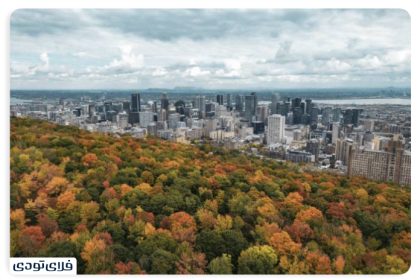Qeshm Island is located in the southernmost point of Iran, on the coast of the Persian Gulf and the Indian Ocean. With its natural and unique attractions, this island has become one of the popular tourist destinations in Iran. One of these amazing attractions is the mangrove forests. Mangrove forests are actually a type of coastal wetlands that grow in the intertidal areas of the Persian Gulf. Mangrove trees with their amazing roots, which are known as aerial roots, have taken root in the salty waters of the Persian Gulf and have created a unique and eye-catching landscape. In this article from Flytoday tourism magazine You will get to know about Qeshm mangrove forest and its activities and you will see the picture of Qeshm mangrove forest.
What is a mangrove forest?
Have you ever seen a floating forest on water? Green trees that have their roots in salt water are under water for hours of the day and sometimes they are seen above the water level and even their roots can be seen. This is a general description of the mangrove forest, but not all!
Mangrove forests, also known as mangrove wetlands, mangrove thickets, or mangals, are valuable wetlands that occur in the intertidal areas of the coast. Mangrove forests mainly grow in tropical and subtropical latitudes because mangrove trees cannot tolerate freezing temperatures. There are about 80 different species of mangroves, all of which grow in areas with low-oxygen soil, where calm waters allow fine sediment to settle.
Mangrove forests in Iran grow in 8 protected areas on the coasts of the Persian Gulf and the Sea of Oman. The northern and western shores of Qeshm Island and the Nayband forest of Bushehr province are among the most important of these areas. The names of this plant are different in different regions of Iran: in Bandar Abbas, it is called Hera, in Balochistan, it is called Tamar, in Bushehr, it is called Gorm, and in some places it is called Tol. Arabs also call it Shuri and Shura.
Mangrove forests are very important by playing vital roles in maintaining the balance of the region’s ecosystem. The roots of mangrove trees prevent soil erosion and protect the coastline. Also, these forests are a safe habitat for all kinds of aquatic animals, birds and benthic animals. Among the mangrove areas in Iran, four areas are under the title of international wetlands, one area is under the title of national marine coastal park, eight areas are under the title of protected area, and one area is under the management of the Environmental Protection Organization as a biosphere reserve.
Protected areas of Iran’s mangrove forest
- Mangrove forests of Nai Band Bay: The widest distribution area of these rare tree communities with an area of 390 hectares is considered to be the last dense and vast collection of these coastal trees in Southwest Asia.
- Asalouye Bushehr mangrove forests: These forests as one of Sights of Asalouye and as the coastal biosphere reserve of the southern waters of the country in the Naiband Marine National Park, it is considered one of the sensitive coastal areas that has sheltered sea salt-loving plants, benthic organisms and oceanic migratory birds in its ecosystem.
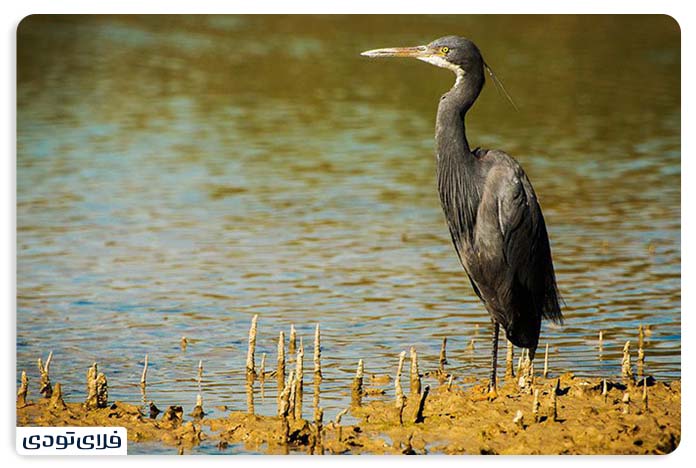
What distinguishes a mangrove forest from other forests?
Mangrove forests are located at the junction of land, ocean and atmosphere and are centers of energy and matter flow between these systems. Due to the various ecological functions of mangrove ecosystems, including prevention of runoff and flooding, storage and recycling of nutrients and waste, cultivation and energy conversion, they have been the focus of many researches. These forests are important hydrocarbon systems that store significant amounts of carbon in marine sediments, thus becoming important regulators of climate change.
Mangrove forests in Iran with many ecological and economic values are considered as important reserves of biodiversity in the southern coasts of the country. The protection and sustainable management of these forests is an undeniable necessity to maintain the balance of coastal and wetland ecosystems in southern Iran. These forests are very important by playing vital roles in maintaining the balance of the region’s ecosystem. The roots of mangrove trees prevent soil erosion and provide a safe habitat for all kinds of aquatic animals and birds.
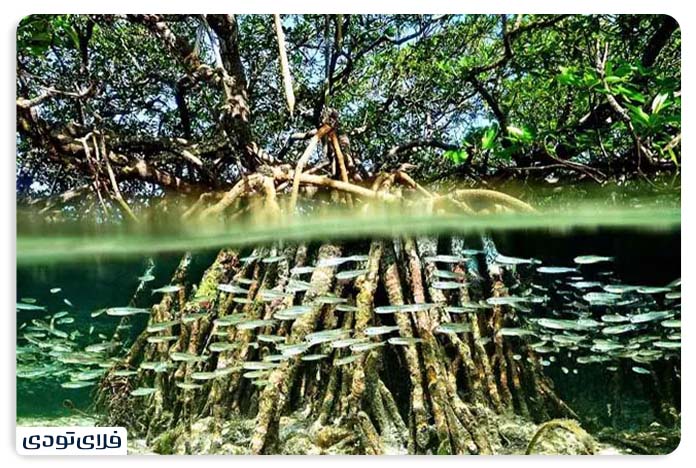
The importance of mangrove forests
- Maintaining the balance of the ecosystem: the roots of mangrove trees prevent soil erosion and maintain the coastline. Also, these forests are a safe habitat for all kinds of aquatic animals and birds.
- Carbon absorption: Mangrove forests play an effective role in reducing the effects of climate change by absorbing carbon from the atmosphere.
- Tourism: The unique beauty of mangrove forests has made them one of the popular tourist destinations in Qeshm.
The distance between Mangrove forest and Qeshm
Where is Qeshm mangrove forest? one of Sights of QeshmQeshm mangrove forest is not far from the city center. Of course, the distance from the mangrove forest to Qeshm depends on the path of the Qeshm mangrove forest, that is, the pier that you use to go to the forest. For example, the distance between Qeshm city and Soheili mangrove forests is 71 km. In this way, you are about an hour away from Qeshm to Mangrove Forest by car.
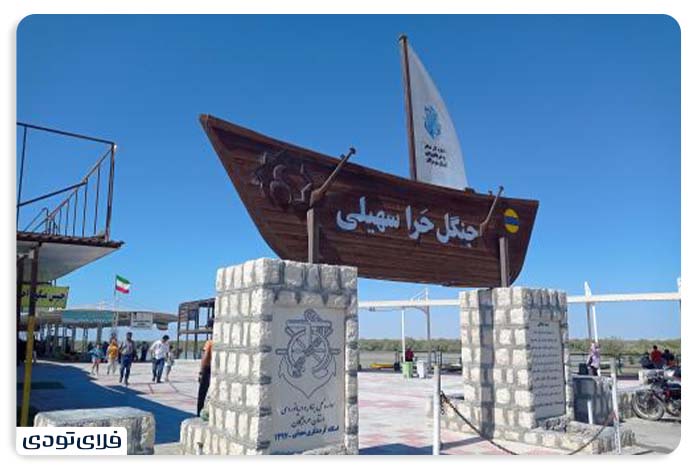
Qeshm mangrove forest on the map

The attractions of Qeshm mangrove forests
Perhaps the most important attraction of the Qeshm mangrove forests is watching the green and dense trees grow in the salt water of the sea. Mangrove trees with their aerial roots, which are known as “respiratory roots”, are among the most adaptable plant species with harsh environmental conditions. These trees have taken root in the salty waters of the Persian Gulf and by absorbing salt, they separate it from the water and in this way, supply the fresh water they need. Next, get to know other attractions of Qeshm mangrove forest.
Recreations in the Qeshm mangrove forest include boating, photography, bird watching, etc. With its unique ecosystem, the mangrove forest acts as a safe habitat for various animals, including aquatic animals, birds, reptiles and mammals. The biodiversity of this forest is proof of its importance and value in maintaining the balance of the region’s ecosystem. The animals of the mangrove forest include fish, frogs, crabs, and stilts. Qeshm mangrove forest is one of the bird watching sites in the country. The birds of Qeshm mangrove forest also include storks, great herons, Indian herons, Gilanshah and gray herons.
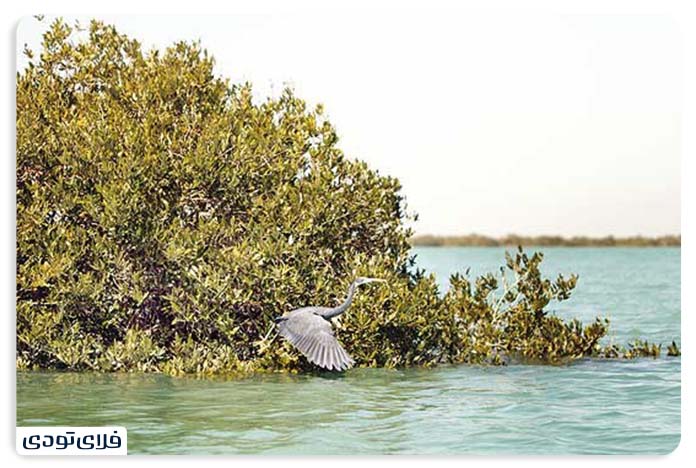
The best time to visit the mangrove forest
The best time to visit the mangrove forest depends on the purpose of your visit and the weather conditions. If you want to see the tides in the mangrove forest, you have to go to this area at low tide. At this time, you can see the roots of mangrove trees sticking out of the water.
If you want to experience boating among the mangroves, you must visit this area during the fashion. For bird watching, early morning is the best time to visit. At this time, birds are active and looking for food. In general, autumn and winter seasons are the best time to visit the mangrove forest. In these seasons, the weather is cooler and pleasant and you are safe from the heat and humidity.
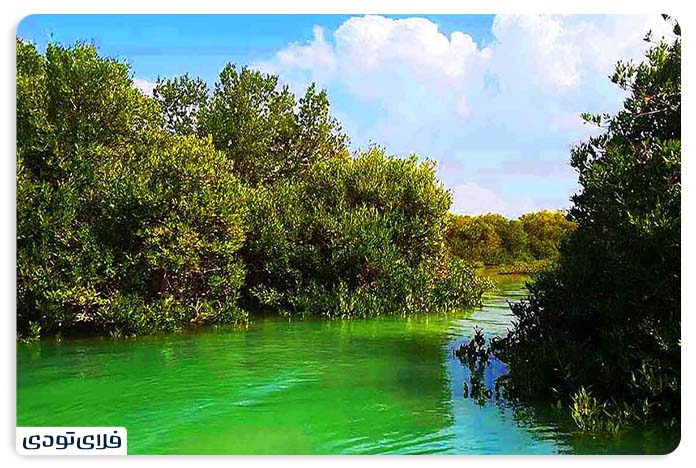
Differences between Qeshm mangrove forest and Hormoz and Chabahar mangrove forest
The Qeshm mangrove forest is different from the Hormoz Chabahar mangrove forest in several ways, which we will mention below.
Extent:
- Qeshm mangrove forest: It is the largest mangrove forest in Iran and the Middle East and covers an area of about 7000 hectares.
- Hormoz mangrove forest: it has an area of about 2000 hectares.
- Chabahar mangrove forest: it has an area of about 600 hectares.
Biodiversity:
- Qeshm Mangrove Forest: It has higher biodiversity and more animal and plant species are found in it.
- Hormoz mangrove forest: It has less biodiversity than Qeshm mangrove forest.
- Chabahar mangrove forest: It has less biodiversity than Qeshm mangrove forest.
Type of trees:
- Qeshm mangrove forest: In this forest, there are mangrove trees of different species such as mangrove, gaz, talap and chandel.
- Chabahar mangrove forest: In this forest, there are mainly mangrove trees of Avicennia marina species.
Features:
- Qeshm Mangrove Forest: There are more amenities and entertainment such as restaurants, accommodation, boat rides and tourist tours.
- Chabahar Mangrove Forest: It has fewer amenities and entertainment facilities.
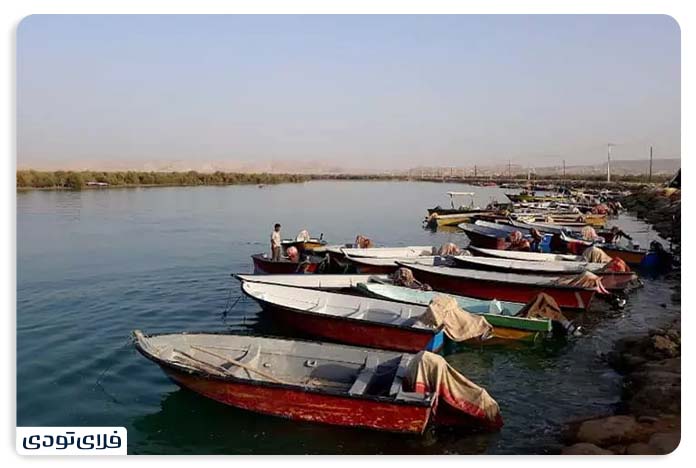
Let’s know other attractions of Qeshm
Qeshm Island, the jewel of the Persian Gulf, is an attractive destination for tourists from all over Iran and the world, with an amazing variety of natural and historical attractions. Sights of Qeshm There are many. From the blue beaches and Dolphin Bay to the Qeshm Geopark and its seven wonders, from the Portuguese castle and historical cemeteries to the Star Valley and the Mangrove Forest, Qeshm has charms for every taste.
On this island, you can walk along the beach and enjoy watching dolphins, explore salt caves and amazing canyons, learn about the rich history and culture of the area in museums and castles, or take a boat ride through the mangrove forest and Enjoy its unique beauty. Qeshm has become one of the most popular tourist destinations in Iran due to the variety of tourist attractions, the favorable weather in autumn and winter, as well as the availability of convenient and recreational facilities, and the Qeshm mangrove forest tour has many fans among nature lovers. has
Excursion in the mangrove forest in Qeshm
The mangrove forest in Qeshm, with its unique beauty and vital role in maintaining the balance of the region’s ecosystem, is of great importance, and visiting these forests will be an attractive and informative experience for tourists, and the beauty of the images of the mangrove forest in Qeshm will be remembered for them. put If you want to see the Qeshm mangrove forest up close, it is enough to visit the section Domestic flightBuy a plane ticket to Qeshm. Would you like to travel by train? train ticket Available from all rail companies. Also, if you are considering a hotel or accommodation, Qeshm hotels It can be easily booked on FlyToday.
Have you ever traveled to Qeshm? Have you seen Qeshm mangrove forest up close? Share your experience of visiting this beautiful forest with us in the comments section.
Frequently asked questions about Qeshm mangrove forest
How much is the ticket price for Qeshm mangrove forest?
Entrance to Qeshm mangrove forest is free, but you have to pay for boat tours and boat rentals. The boats have a capacity of 5 people and in 1403 the cost was 90 thousand tomans.
How many kilometers is the distance from Qeshm to Mangrove Forest?
The distance from Qeshm to the mangrove forest is about 60 km.
Where is the best residence in Qeshm mangrove forest?
The best accommodations near Qeshm Hara Forest include Pir Hara, Nakhda Amini, Haft Rango, Kaka, and Nachidar ecotourism accommodations that provide amenities and easy access to this natural attraction.
Where is Qeshm mangrove forest?
This forest is located in the Khoran Strait between Qeshm Island and a part of Hormozgan province, the distance between the north of Qeshm Island and Khamer Port.
How far is Qeshm from Mangrove Forest?
The distance between Qeshm city and Soheili mangrove forests is 71 km.
What are the differences between the mangrove forest of Qeshm and the mangrove forest in Hormoz and Chabahar?
These forests differ in size, biodiversity, types of trees, facilities and tourist attractions.
When is the best time to watch Qeshm mangrove forest?
Autumn and winter seasons are more suitable because the weather is cooler.
RCO NEWS















